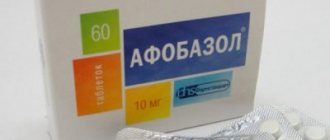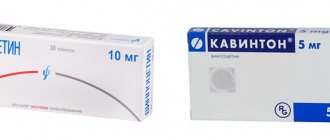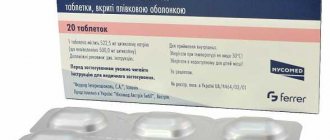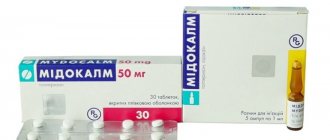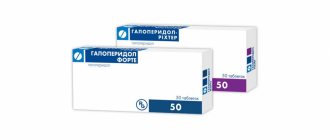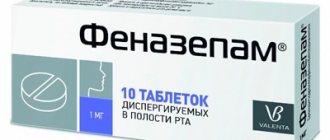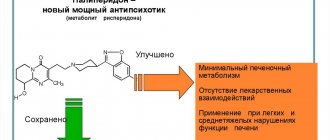Prohibited during pregnancy
Prohibited during breastfeeding
Has restrictions for children
Has restrictions for older people
Has limitations for liver problems
Anvifen is a nootropic drug containing the active substance aminophenylbutyric acid. It is used in neurology for asthenic and anxiety-neurotic conditions. For children, the drug is prescribed for enuresis and stuttering.
Packaging of Anvifen
Elderly people are recommended to take Anvifen for insomnia, anxiety, and dizziness caused by dysfunction of the vestibular analyzer of various etiologies. The drugs are not prescribed to pregnant patients, patients with hypersensitivity to any components of the drug, or lactating mothers. It is also contraindicated in children under 3 years of age.
Capsules are taken only orally after meals, 250-500 mg per day for adult patients and adolescents over 14 years of age. It is possible to adjust the dose of the medicine, but this can only be done by a doctor.
The drug is dispensed strictly according to a doctor's prescription. This is a potent drug, self-medication with which can be harmful. If the situation is not too critical, you can find analogues of Anvifen - no less effective, but safer.
Nosological classification (ICD-10)
- F06.6 Organic emotionally labile [asthenic] disorder
- F10.3 Withdrawal state
- F41.9 Anxiety disorder, unspecified
- F48.9 Neurotic disorder, unspecified
- F95.9 Tics, unspecified
- F98.0 Enuresis of inorganic nature
- F98.5 Stuttering [stammering]
- G47 Sleep disorders
- H81.0 Meniere's disease
- H81.4 Dizziness of central origin
- H81.9 Vestibular function disorder, unspecified
- T75.3 Motion sickness
Compound
| Capsules | 1 caps. |
| active substance: | |
| aminophenylbutyric acid hydrochloride | 25 mg |
| 50 mg | |
| 125 mg | |
| 250 mg | |
| excipients: hyprolose - 1.3/1.3/1.7/2 mg; colloidal silicon dioxide - 3.2/3.2/4/8 mg; lactose - 109.1/84.1/42.5/86.5 mg; magnesium stearate - 1.4/1.4/1.8/3.5 mg | |
| hard gelatin capsule: for a dosage of 25 mg - water, gelatin, titanium dioxide (E171); for a dosage of 50 mg - water, gelatin, azorubine dye (E122), brilliant blue dye (E133), quinoline yellow dye (E104), titanium dioxide (E171); for a dosage of 125 mg - water, gelatin, azorubine dye (E122), brilliant blue dye (E133), titanium dioxide (E171); for a dosage of 250 mg - water, gelatin, azorubine dye (E122), brilliant blue dye (E133), titanium dioxide (E171) |
Description of the dosage form
Capsules, 25 mg: hard gelatin, size No. 3, white.
Capsules, 50 mg: hard gelatin, size No. 3, white body, blue cap.
Capsules, 125 mg: hard gelatin, size No. 2, white body, blue cap.
Capsules, 250 mg: hard gelatin, size No. 0, white body, dark blue cap.
Capsule contents: a mixture of powder and/or granules of white or white with a yellowish tint.
Pharmacodynamics
A nootropic agent that facilitates GABA-mediated transmission of nerve impulses to the central nervous system (direct effect on GABAergic receptors). The tranquilizing effect is combined with an activating effect. It also has antiplatelet, antioxidant and some anticonvulsant effects.
Improves the functional state of the brain by normalizing its metabolism and influencing cerebral blood flow (increases volumetric and linear velocity, reduces vascular resistance, improves microcirculation, and has an antiplatelet effect). Extends the latent period and shortens the duration and severity of nystagmus.
Does not affect cholinergic and adrenergic receptors. Reduces vasovegetative symptoms (including headache, feeling of heaviness in the head, sleep disturbance, irritability, emotional lability). When taken as a course, it increases physical and mental performance (attention, memory, speed and accuracy of sensory-motor reactions).
Reduces manifestations of asthenia (improves well-being, increases interest and initiative - motivation for activity) without sedation or agitation.
Helps reduce feelings of anxiety, tension and restlessness, and normalizes sleep.
In elderly people, it does not cause depression of the central nervous system; the muscle-relaxing aftereffect is most often absent.
Reviews
Reviews from doctors:
- “It’s a good drug, I prescribe it as an anti-anxiety drug. Compared to analogues, the advantage is a convenient dosage.”
- “Anvifen is effective in the treatment of improving cognitive functions and normalizing brain microcirculation. Side effects occur rarely, unlike analogues. There are few contraindications."
- “It’s convenient that Anvifen simultaneously has several types of effects on the body: nootropic, tranquilizing, antioxidant, antiplatelet. There is no need to prescribe multiple drugs. It gives an immediate calming effect and has a positive effect on brain function and normalizes blood circulation.”
- “Tranquilizers have an impressive list of side effects; patients often responded by feeling worse. Such situations do not arise when Anvifen is prescribed.”
Patient reviews:
- “I felt an improvement from the first pill.”
- “An excellent drug, it quickly helped with insomnia and irritability.”
- “Anvifen helped me with panic attacks, from the first days I felt the effect and gradually the attacks stopped completely.”
- “I take Anvifen when my performance decreases due to stress; when I take it, my strength, concentration, memory increase, my mood improves and my spirits rise. Fits me great. I recommend".
Pharmacokinetics
Absorption is high, penetrates well into all tissues of the body and through the BBB (about 0.1% of the administered dose of the drug penetrates into brain tissue, and in young and elderly people to a much greater extent). Evenly distributed in the liver and kidneys. Metabolized in the liver - 80–95%, metabolites are pharmacologically inactive. Does not accumulate. After 3 hours, it begins to be excreted by the kidneys, while the concentration in the brain tissue does not decrease and is detected for another 6 hours. About 5% is excreted by the kidneys unchanged, partially with bile.
Literature:
- Pharmacology of antiepileptic drugs: a textbook for students in specialty programs “General Medicine”, “Pediatrics”, “Pharmacy” / I. A. Vinogradova, V. D. Yunash, S. V. Goranskaya [etc.]; Ministry of Science and Higher Education of the Russian Federation, Federal State Budgetary Educational Institution of Higher Education Petrozavodsk State University. — Petrozavodsk: PetrSU Publishing House, 2021. — 32 p.
- Kozlovsky, Vladimir Leonidovich. / Brief reference book on psychopharmacology, pharmacotherapy and mental pathology - St. Petersburg: SpetsLit, 2015.
- Neurology: national guide / Avakyan G. N. et al.; Ch. ed.: E.I. Gusev [etc.]; Assoc. honey. Island for Quality, ASMOK, All-Russian Society of Neurologists. - Moscow: GEOTAR-Media, 2009. - 1035 p.
Directions for use and doses
Orally, after meals, in 2-3 week courses.
Adults and children over 14 years of age - 250-500 mg 3 times a day (maximum daily dose - 2500 mg). Children 3–8 years old - 50–100 mg 3 times a day; 8 - 14 years - 250 mg 3 times a day.
The single maximum dose for adults and children over 14 years of age is 750 mg, for persons over 60 years of age - 500 mg, for children under 8 years of age - 150 mg, from 8 to 14 years of age - 250 mg.
Alcohol withdrawal syndrome: 250–500 mg 3 times a day and 750 mg at night, with a gradual reduction in the daily dose to the usual for adults.
Treatment of dizziness with dysfunction of the vestibular apparatus and Meniere's disease: 250 mg 3 times a day for 14 days.
Prevention of motion sickness: 250–500 mg once, 1 hour before the expected start of motion sickness or when the first symptoms of seasickness appear.
The anti-motion sickness effect of Anvifen® increases with increasing dose of the drug. When severe manifestations of seasickness occur (vomiting, etc.), the use of Anvifen® is ineffective even in doses of 750–1000 mg.
Substitutes for Anvifen according to their effect on the body
As analogues of Anvifen, which have a similar therapeutic effect, but differ in composition, we can consider the drugs Nozepam, Alprazolam, Fenzitate, Glycine, Tenoten.
Nozepam
Nozepam is an analogue of Anvifen, made on the basis of the active component oxazepam. The drug is effective for:
- neuroses;
- neurasthenia;
- sleep and falling asleep disorders;
- exposure to stress;
- increased excitability of patients with chronic alcoholism;
- vegetative lability in women;
- anxiety, fear of any origin.
It is recommended to start therapy with the minimum dosage of Nozepam, which is 10 mg. Reception is carried out 2-3 times/day. Then the dose is increased gradually, under the careful supervision of a doctor. The average course of Nozepam therapy lasts from 2 to 4 weeks.
The drug is not prescribed:
- if the patient is hypersensitive to the components of the drug;
- during pregnancy;
- during the lactation period;
- patients with psychosis, acute or chronic acute renal or liver failure;
- in case of drug intoxication;
- in case of poisoning with ethyl alcohol;
- patients with angle-closure glaucoma;
- children under 6 years old;
- persons with severe respiratory failure.
Taking the medication can lead to general weakness, drowsiness, confusion, dizziness, and nausea. Less often, patients complain of stomach pain, allergies, and nausea.
The main differences between Nozepam and Anvifen are composition and price.
Alprazolam
Alprazolam is a medication containing 0.25 or 1 mg of active substance in 1 tablet of the same name. It is an anxiolytic that has antidepressant, sedative, hypnotic, and anticonvulsant effects.
Alprazolam is intended for patients suffering from:
- neuroses and neurosis-like disorders;
- anxiety, fear, worry;
- depression;
- panic attacks;
- withdrawal symptoms (including alcohol and drugs).
For adult patients, Alprazolam is initially prescribed at a dose of 0.1-0.2 mg 2-3 times a day. If necessary, the dose is increased, but not earlier than 1-2 weeks from the moment of first taking the tablet.
Important! Alprazolam withdrawal should be carried out in the same stages as increasing its dosage. If you suddenly stop taking the pills, withdrawal syndrome may develop.
Tablets should not be prescribed for the treatment of patients with:
- respiratory failure;
- lactose intolerance;
- severe impairment of renal or hepatic activity;
- myasthenia;
- acute glaucoma;
- acute alcohol intoxication;
- poisoning with narcotic or pharmaceutical drugs.
The medication is not used in pediatrics. It is also contraindicated during the gestational and lactation periods.
Common side effects caused by the use of Alprazolam are:
- depressive states;
- tremor;
- sleep disorders;
- drowsiness;
- absentmindedness;
- restlessness, anxiety;
- stomach pain;
- nausea;
- belching;
- visual impairment.
These reactions can either occur at the very beginning of the therapeutic course or manifest themselves throughout its entire duration.
Alprazolam differs from Anvifen in composition, features of use, some indications, and also price.
Fenzitate
Fenzitate is an anxiolytic containing bromodihydrochlorophenylbenzodiazepine at a dose of 0.5 or 1 mg/tab. It has a pronounced hypnotic, sedative, muscle relaxant, and anticonvulsant effect. Prescribed for:
- neurotic, neurosis-like, neurasthenic disorders;
- psychopathic and psychopath-like states;
- reactive psychoses;
- autonomic dysfunctions;
- problems with sleep and falling asleep;
- hyperkinesis;
- ticks;
- muscle rigidity.
Tablet drugs should not be prescribed to patients with:
- severe myasthenia gravis;
- severe renal or hepatic dysfunction;
- poisoning with other anxiolytic, neuroleptic, hypnotics, sedatives, narcotic medications or ethanol.
Fenzitate is prohibited during pregnancy, breastfeeding, and children under 18 years of age.
Take the drug in a dose of 0.5-1 mg, for night sleep disorders - 0.25-0.5 mg. It is important to consider that the dosage is selected taking into account the diagnosis, and the duration of treatment also depends on this.
Taking Phensitate may be accompanied by:
- muscle weakness;
- dizziness;
- headaches;
- nausea;
- drowsiness;
- ataxia;
- problems with remembering;
- absent-mindedness.
The difference between Fenzitate and Anvifen is the price, composition, and application features.
Glycine
Glycine is a metabolic agent containing an active substance of the same name. The use of these tablets is due to:
- decreased mental performance;
- exposure to stress;
- deviant behavioral forms in children and adolescents;
- increased excitability, irritability, aggressiveness;
- attacks of unreasonable fear, panic;
- suffered an ischemic stroke.
Glycine is not used to treat patients with intolerance to the components of the tablets. You cannot combine the drug with alcohol. Also, do not give tablets to children under 3 years of age. It is not recommended to take drugs during gestation and pregnancy, although there is no data on possible harm to the fetus or infant.
For cognitive impairment, the dose of Glycine is the same for all age categories and is 1 tablet. 2-3 times/24 hours. You can take a maximum of 3 tablets per day. The duration of treatment ranges from 7 to 14 days. Extremely rarely, Glycine can cause urticaria, rhinitis, conjunctivitis, sore throat, and weakness.
Glycine differs from the main drug in its pharmacological group, some indications, composition, and price.
Tenoten
Tenoten is a homeopathic drug that has anti-anxiety, sedative, and mild hypnotic effects. Unlike many similar drugs, it does not have a hypnogenic or muscle relaxant effect on the body.
The drug is dispensed in the form of lozenges. It is noteworthy that there are 2 versions of Tenoten - for adults and for children. They contain the same active substance, but in different doses. The active component of both forms of the drug are affinity-purified antibodies to the brain-specific protein S-100.
Tenoten is indicated for nervous disorders, insomnia, frequent stress, irritability, and aggressiveness. The drug should not be taken if you are intolerant of its components.
The tablets are intended for resorption. Adults can take no more than 2 pieces per dose. Usually the frequency of applications is 2 times, but it can be increased to 4 times/24 hours. The course of therapy should be continued for 1 to 3 months. It can be repeated after a 30-60 day break.
Children over 3 years of age are prescribed Tenoten 1 tablet/day. If necessary, the drug can be pre-dissolved in a small amount of water. The duration of therapy is the same as for adults. The drug causes virtually no negative reactions. Occasionally, complaints of drowsiness, dizziness, and allergies may appear.
Tenoten differs in many ways from the main medication. It has a different pharmacological group, a different composition, has a special version for children, and is very different in price.
See also:
TOP 8 cheap analogues of Diazepam - drug substitutes
